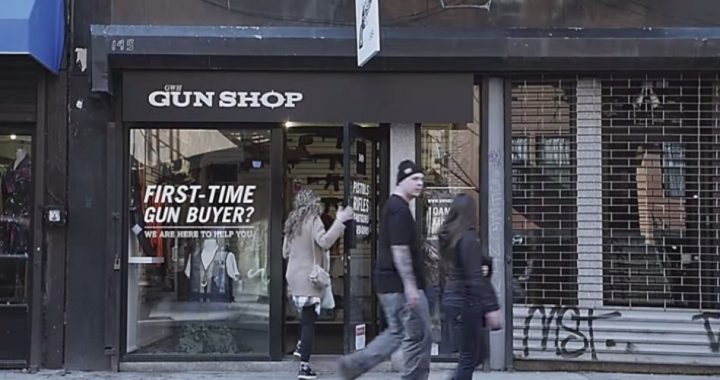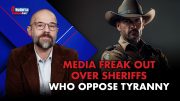
“A gun store opened in Manhattan….” It sounds like the beginning of a story — or a tale. And the effort essentially was fiction.
Critics would say its message was fiction, too.
As the salesman behind the counter showed one couple a firearm, he said to the husband, “It’s the easiest gun we have to use…. It’s a .22 caliber, six-inch revolver. It’s also a gun that a 5-year-old found in his parents’ bedroom [and] went and shot his 9-month-old baby brother with.”
What was being sold, you see, wasn’t guns but gun control. The store, set up on Manhattan’s liberal Lower East Side, equipped with hidden cameras, and given the imaginative name “Gun Shop,” was open just two days last week. The video footage shot was then used in an ad. Writes PIX11:
The gun shop … [was] a social experiment orchestrated by the States United Against Gun Violence organization. “The goal really was to inform and educate people who are thinking of owning a gun to think twice about that decision,” Leah Gunn Barrett, Executive Director of New Yorkers Against Gun Violence, told PIX11 News.
According to Barrett, the bold ad was in response to a newly released poll that showed less than half of Americans support stricter gun laws. “Eighty-eight people a day die from gun violence in the United States,” she said. “Two-thirds of those are suicides. This is a public health crisis and we need people to treat guns as the lethal weapons they are.”
The shop … was outfitted with nearly 100 authentic-looking yet fake prop weapons.
The firearms shown to customers had tags on them describing their supposedly nefarious histories, whether it was the incident involving the five-year-old, the crime perpetrated by Newtown shooter Adam Lanza, or something else. The prospective gun buyers were, not surprisingly, taken aback. But while the Washington Post and others opined that the approach “appeared to … work” in at least some cases, one might wonder. Did the looks on the customers’ faces suggest anything other than surprise that a firearms salesman would take such a tack? Will the ad (shown below) be any more effective than a December anti-gun PSA — showing a young adolescent finding a handgun in his parents’ drawer and then bringing it to school — that was panned by critics on both sides of the issue? For sure, this latest effort could also be viewed as shallow, patronizing propaganda.
And it certainly is one sided. Upon showing a customer an AR-15, the fake proprietor pointed out that it was a gun used by Adam Lanza in the 2012 Newtown shooting. This is true. It’s also true that a 15-year-old Texas boy used an AR-15 to defend himself and his 12-year-old sister against two burglars in 2010, shooting one of them and causing both to flee. Then there was the Rochester Institute of Technology student who used an AR-15 in 2013 to scare off two armed intruders. In fact, this site here relates these events and three other such uses of AR-15, assault-prevention rifles.
These are hardly the only examples of defensive gun use, however. As I wrote in 2013, Florida State University criminologist, self-described liberal Democrat, and lifelong ACLU member Gary Kleck “estimates that 2.5 million Americans each year use guns for self-defense and that 400,000 of them say they would have been killed if they hadn’t been armed. That’s 400,000 a year.”
One of these people was 12-year-old Oklahoman Kendra St. Clair; home alone one day in 2012, she used her mother’s .40-caliber Glock to shoot and scare off a 32-year-old home invader. In 2010, there was the 11-year-old Palmview, Texas, boy who, after being shot by two armed and masked illegal aliens breaking into his home, returned fire with his .22-caliber rifle, striking one in the neck and causing both to flee. And I relate other such stories in my New American piece,“When Kids and Guns Mix.”
Of course, critics could challenge the notion that 400,000 additional Americans a year would be murdered were it not for defensive gun use. And, in fairness and unlike in the anti-gun ad, perspective should be provided. As I also wrote in 2013:
Do I believe they all would have been murdered? No…. But even if only one half of one percent of them are correct, that’s 2000 innocent lives saved with guns every year. This is approximately 76 times as many as were killed at Sandy Hook and considerably more than were lost in all American gun massacres during the last 40 years. And if five percent of them are right, it amounts to 20,000 innocent lives saved — far more than the number murdered with guns in America every year.
In contrast to the above, the gun-store project involved mainly emotional appeals. “Pitching” a 9mm. handgun to a customer, the salesman said the weapon was “easy to use” and then mentioned the 2014 Idaho incident in which a two-year-old boy accessed his mother’s 9mm. and killed her inside a Wal-Mart. But this could be applied to many things. A car salesman could undoubtedly pitch any given model vehicle, cite an incident in which a drunk driver used it to kill a mother and say, as did the fake gun salesman, “Dead, gone, no mom.” Or a prospective swimming-pool buyer could be told, “Hey, this is the type of pool little Timmy Adams drowned in.” And a sporting-goods proprietor could affix to a baseball bat a tag stating, “Model swung by the five-year-old who accidentally killed his younger brother in 2012.” It’s great rhetoric — but poor analysis.
Speaking of which, there’s no correlation between strict gun-control laws and reduced murder. Camden, Trenton, and Newark are among the nation’s top 10 cities in per-capita murder rate despite being in New Jersey, which has some of America’s toughest gun laws. New Hampshire has a considerably higher gun-ownership rate than Great Britain but a murder rate that is lower and comparable to that of Western Europe in general. There are nations with stricter gun-control laws than the United States but higher homicide rates, such as Russia, Mexico, and Brazil. And as Dr. Thomas Sowell wrote in 2012, “Gun ownership has been three times as high in Switzerland as in Germany, but the Swiss have had lower murder rates.” What explains this? According to Sowell, the difference is “neither guns nor gun control…. People [are] the difference.”
The anti-gun ad closes with, “Every gun has a history. Let’s not repeat it.” But while Kendra St. Clair, a number of fellow children and teens, and 2.5 million other Americans would agree that every gun has a history, they might point out that repeating it is sometimes a very, very good idea.
Photo: Screengrab from anti-gun ad



